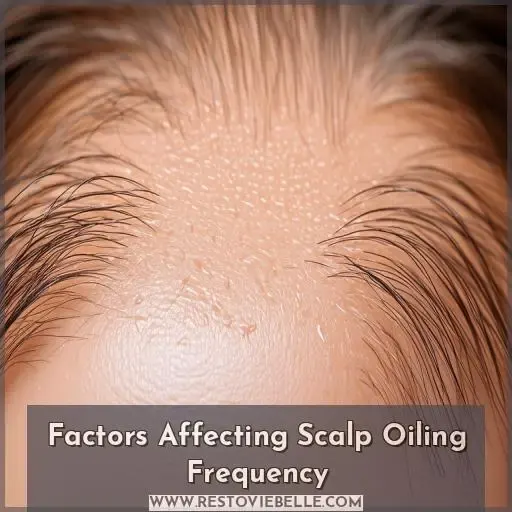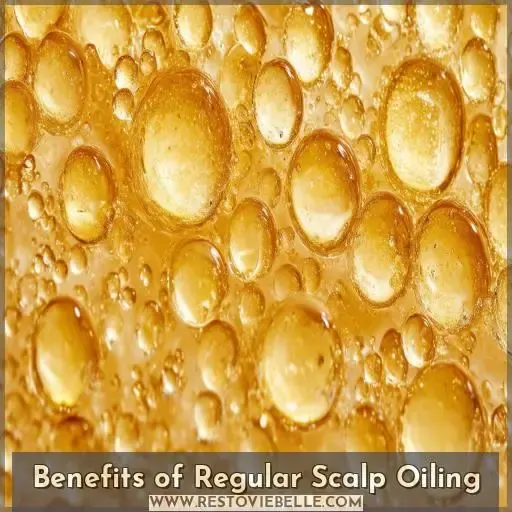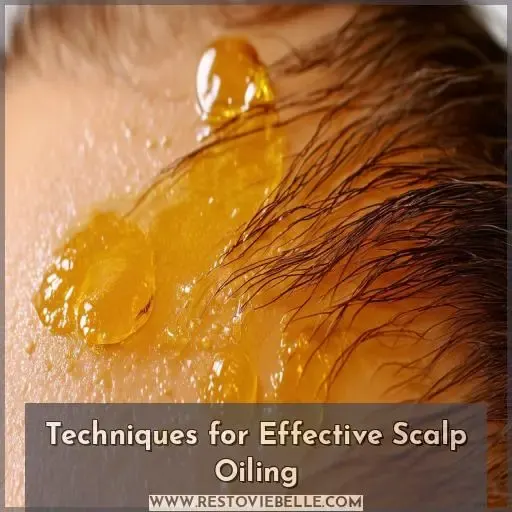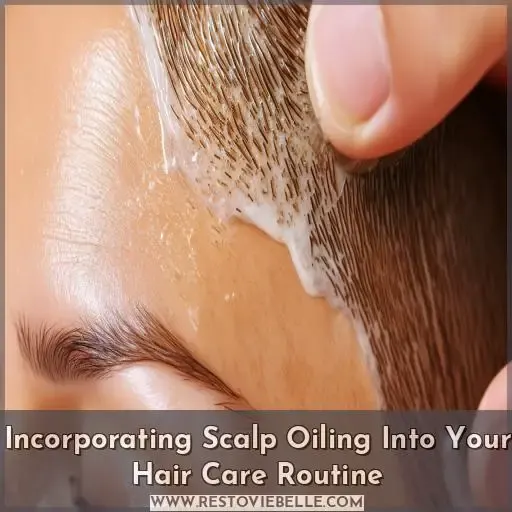This site is supported by our readers. We may earn a commission, at no cost to you, if you purchase through links.
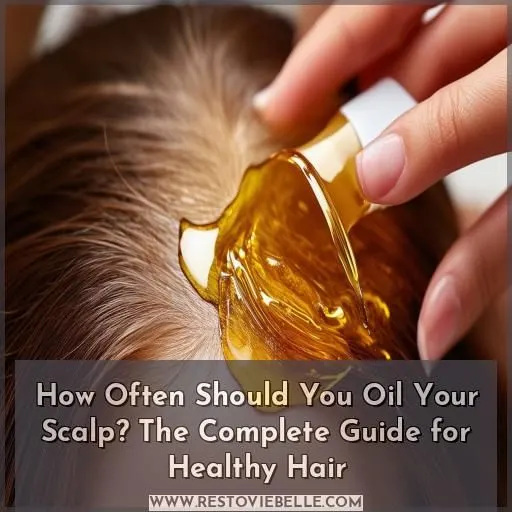 How often should you oil your scalp? The answer isn’t one-size-fits-all. Your hair type, scalp condition, and personal preferences determine the ideal frequency.
How often should you oil your scalp? The answer isn’t one-size-fits-all. Your hair type, scalp condition, and personal preferences determine the ideal frequency.
As a general guide, those with dry scalps may benefit from oiling 2-3 times weekly, while oily scalps should limit it to once every 2-4 weeks. For normal scalps, bi-weekly or monthly oiling strikes the right balance.
Table Of Contents
Key Takeaways
- Oiling your scalp is like giving your hair a refreshing drink—too much and you risk drowning it, too little and it’ll be parched. Finding that sweet spot is the key to luscious locks.
- Your hair type holds the secret code to oiling frequency. Thick, coarse strands crave more moisture, while fine hair prefers a lighter touch. It’s like a Goldilocks tale—get it just right, and your hair will be living its best life.
- Treat your scalp like a high-maintenance diva—give it what it wants, when it wants it. A dry scalp might demand weekly pampering, while an oily one needs a break every few weeks. Listen to its tantrums, and you’ll have a happy, healthy mane.
- Oiling isn’t just about hair—it’s a full-body experience. Massage those oils in like you’re giving your scalp a spa day. The increased blood flow is like a shot of vitamins straight to your strands, promoting growth and strength from the roots up.
How Often Should You Oil Your Scalp?
How often should you oil your scalp? Generally, you should oil your scalp once a week for normal to dry hair types, and twice a week for very dry scalp conditions. The frequency depends on your hair type, scalp condition, and personal preferences.
Factors Affecting Scalp Oiling Frequency
The frequency at which you should oil your scalp depends on several factors, including your hair type, scalp condition, and personal preferences. Understanding these variables can help you determine the ideal oiling routine to maintain a healthy scalp and promote hair growth.
Hair Type
Your hair type plays a pivotal role in determining oiling frequency. Coarse, curly, and thick hair typically need more frequent oiling than fine, thin hair. The strands’ porosity and oil absorption rate also matter—coarse hair tends to be drier, requiring more oil. Understanding your unique hair characteristics helps you strike the perfect balance for optimal scalp health.
Scalp Condition
Your scalp’s condition also dictates oiling frequency. If you have dandruff, dermatitis, or psoriasis, oiling more often can help soothe itchiness and flakiness. But overactive sebum production calls for less frequent oiling. Similarly, a sensitive scalp may require gentler oils used sparingly to avoid irritation. Regular exfoliation complements oiling for scalp health.
Personal Preferences
Your personal preferences and lifestyle also influence scalp oiling frequency. Seasonal variations, activity levels, and time constraints can impact how often you need to oil. Some prefer daily oiling, while others find weekly or bi-weekly oiling more suitable. Ultimately, you should develop a routine that aligns with your scalp’s needs and your lifestyle.
Benefits of Regular Scalp Oiling
Regular scalp oiling offers numerous benefits for maintaining healthy hair. It nourishes and moisturizes the scalp, preventing dryness and flakiness, stimulates blood circulation to promote hair growth, helps prevent premature hair loss, and adds shine and manageability to your tresses.
Nourishing and Moisturizing the Scalp
Oiling nourishes your scalp by delivering essential nutrients and fatty acids. These oils penetrate the scalp, hydrating and moisturizing from within. As the oils absorb, they replenish your scalp’s natural oils depleted by factors like over-washing. Proper oiling and massage encourage oil absorption for a conditioned, rejuvenated scalp.
Preventing Dryness and Flakiness
Regular scalp oiling prevents dryness and flakiness by sealing in moisture. Oils create a protective barrier that locks hydration into the scalp, preventing it from becoming parched and developing dandruff. This improved scalp health leads to manageable hair and supports robust growth without the hindrance of irritation or scaling.
Stimulating Blood Circulation
Regular scalp oiling stimulates blood circulation, promoting hair growth and overall scalp health. Massaging with your fingertips increases blood flow, delivering nutrients essential to hair follicles. This improved circulation:
- Enhances hair strength and shine
- Prevents premature graying
- Reduces hair loss and thinning
- Nourishes follicles from within
- Boosts oil absorption for maximum benefits
Promoting Hair Growth
Oiling your scalp nourishes hair follicles, reducing inflammation that impedes growth. The massaging action also stimulates blood flow, delivering nutrients essential for healthy hair production.
| Follicle Health | New Growth | Scalp Condition |
|---|---|---|
| Oils replenish | Promotes active growth cycles | Anti-inflammatory effects reduce irritation |
Lustrous new strands replace split, damaged hairs for fuller, thicker locks.
Preventing Premature Hair Loss
Regularly oiling your scalp can prevent premature hair loss by nourishing hair follicles and promoting scalp health. It stimulates blood circulation, strengthening hair roots. Here are three benefits:
- Massage boosts hair follicle stimulation, increasing hair density.
- Oils combat dryness, preventing dandruff and irritation that cause fallout.
- Proper scalp oiling improves overall scalp health for thicker, fuller hair.
Adding Shine and Manageability
Regular scalp oiling tames frizz and detangles unruly strands, leaving you with luscious, manageable locks. The oils create a protective barrier against heat damage from styling tools, preventing split ends and preserving your hair’s vibrant color. With added shine and smoothness, your tresses will be the envy of all.
Guidelines for Scalp Oiling Frequency
The advisable frequency for scalp oiling depends on your scalp type – those with dry scalps generally require more frequent oiling, while oily scalps may need less frequent applications. Determining the appropriate frequency involves considering factors like your hair type, scalp condition, and personal preferences.
Dry Scalp
Your dry scalp needs frequent oiling to:
- Soothe scalp irritation and combat dandruff
- Nourish follicles for lice prevention
- Minimize hair breakage and split ends
- Restore moisture for healthy hair growth
Aim to oil your dry scalp 2-3 times weekly. Massage warm oil into the scalp, leave it overnight, and shampoo thoroughly. Be diligent with this routine for luscious, flake-free locks.
Oily Scalp
On the other hand, if you have an oily scalp prone to excessive sebum production, you’ll want to oil your scalp less frequently. Oiling too often can exacerbate oiliness, leading to greasy hair and clogged pores. Aim for oiling every 2-4 weeks, depending on your hair’s needs. Pay close attention to how your scalp responds.
Normal Scalp
If you have a normal scalp, oil it once every 2-3 weeks. A normal scalp strikes a balance—not too dry or oily. Oiling helps nourish and moisturize, promoting healthy hair growth without scalp sensitivity or irritation. Pay attention to how quickly your scalp absorbs oil; adjust frequency accordingly for effective oil absorption without over-oiling.
Techniques for Effective Scalp Oiling
To effectively oil your scalp, you’ll want to choose an oil that suits your hair type and scalp condition. Apply the oil generously to your scalp, gently massaging it with your fingertips in circular motions to promote absorption and stimulate blood flow.
Choosing the Right Oil
After identifying your scalp’s needs, the next critical step is selecting the appropriate oil. Consider your 1) hair porosity, 2) desired oil properties, and 3) preferred botanical oils. Oils with a light consistency, such as argan or marula, are suitable for low-porosity hair, while thicker oils like coconut or olive are ideal for high-porosity strands. Oils with warmth can enhance absorption.
Applying the Oil
Once you’ve chosen the right oil, it’s time to apply it. Start with dry hair and use your fingertips to gently massage the oil onto your scalp. Work in sections, focusing on one area at a time, ensuring even coverage. Apply enough oil to coat your scalp without oversaturating. Avoid getting oil on your hair shafts.
Massaging the Scalp
After applying the oil, gently massage your scalp with your fingertips. Focus on pressure points to stimulate blood circulation and nourish follicles, promoting hair growth. Massaging also helps distribute the oil evenly, preventing dandruff and hair loss while enhancing shine. Be gentle, but firm, for best results.
Leaving the Oil On
Once you’ve massaged the oil into your scalp, leave it on overnight for deep conditioning and anti-inflammatory benefits. Overnight protection allows the oil’s nutrients to fully penetrate, nourishing your scalp and promoting hair growth. In the morning, rinse thoroughly and enjoy your revitalized, healthy locks.
Incorporating Scalp Oiling Into Your Hair Care Routine
Incorporating scalp oiling into your hair care routine is vital for maintaining healthy locks. The frequency depends on your hair type, scalp condition, and personal preferences, ranging from weekly oiling for dry scalps to monthly applications for those with oilier strands.
Weekly Oiling
If you have dry hair or a dry scalp, weekly oiling is ideal. Hot oil treatments can deeply nourish and hydrate, promoting scalp health and preventing hair loss. For normal hair types, weekly oiling with lightweight oils like coconut or argan oil can enhance shine and manageability without weighing strands down. Remember, consistent oiling supports hair growth.
Bi-weekly Oiling
If a weekly oiling routine is too frequent for your needs, bi-weekly scalp oiling could be the perfect compromise. This approach allows you to:
- Maintain scalp health without over-oiling
- Stimulate hair growth and prevent hair loss
- Enjoy the benefits of a relaxing scalp massage
- Nourish your strands without weighing them down
With bi-weekly oiling, you can strike a balance between nourishment and manageability for your specific hair type and lifestyle.
Monthly Oiling
For those with normal hair, a monthly warm oil treatment can be a luxurious way to nourish your scalp.
First, blend oils like coconut and almond with a few drops of essential oils.
Next, massage the scalp with this warm oil blend and leave it overnight before shampooing.
This monthly indulgence provides deep conditioning while stimulating blood flow for healthier locks.
Frequently Asked Questions (FAQs)
Can oiling the scalp cause hair thinning?
Moderate oiling of the scalp is generally safe and beneficial for hair health. However, excessive oiling can clog pores, leading to buildup that may contribute to thinning or hair loss over time. Strike a balance by oiling judiciously and rinsing thoroughly afterward.
Is coconut oil best for scalp oiling?
You’re in luck – coconut oil is excellent for scalp oiling! Its anti-microbial properties soothe irritation while nourishing strands. Still, don’t overdo it – moderation is key for healthy, luscious locks.
How often should I oil during pregnancy?
Oiling during pregnancy is recommended weekly. However, consult your doctor, as overdoing it can cause issues. Use plant-based oils like coconut or almond and gently massage your scalp for best nourishment.
Should I oil my scalp after coloring?
Oiling your scalp after coloring isn’t necessary but can help nourish and protect your hair. Use a mild, color-safe oil like coconut or argan oil a few times per week. Avoid oiling right after coloring to prevent premature fading.
Can oiling help with dandruff and itchiness?
Oiling your scalp can help alleviate dandruff and itchiness. The oils nourish the skin, reducing flakiness and dryness that trigger irritation. But use oils sparingly; excessive oiling may clog pores and worsen dandruff.
Conclusion
Finding the perfect frequency to oil your scalp may feel like a quest for the holy grail, but it’s within reach.
Listen to your body – how often should you oil your scalp?
The answer lies in your hair type, scalp condition, and personal needs.
Embrace this customized approach, and you’ll discover the secret to healthy, radiant tresses that turn heads.
